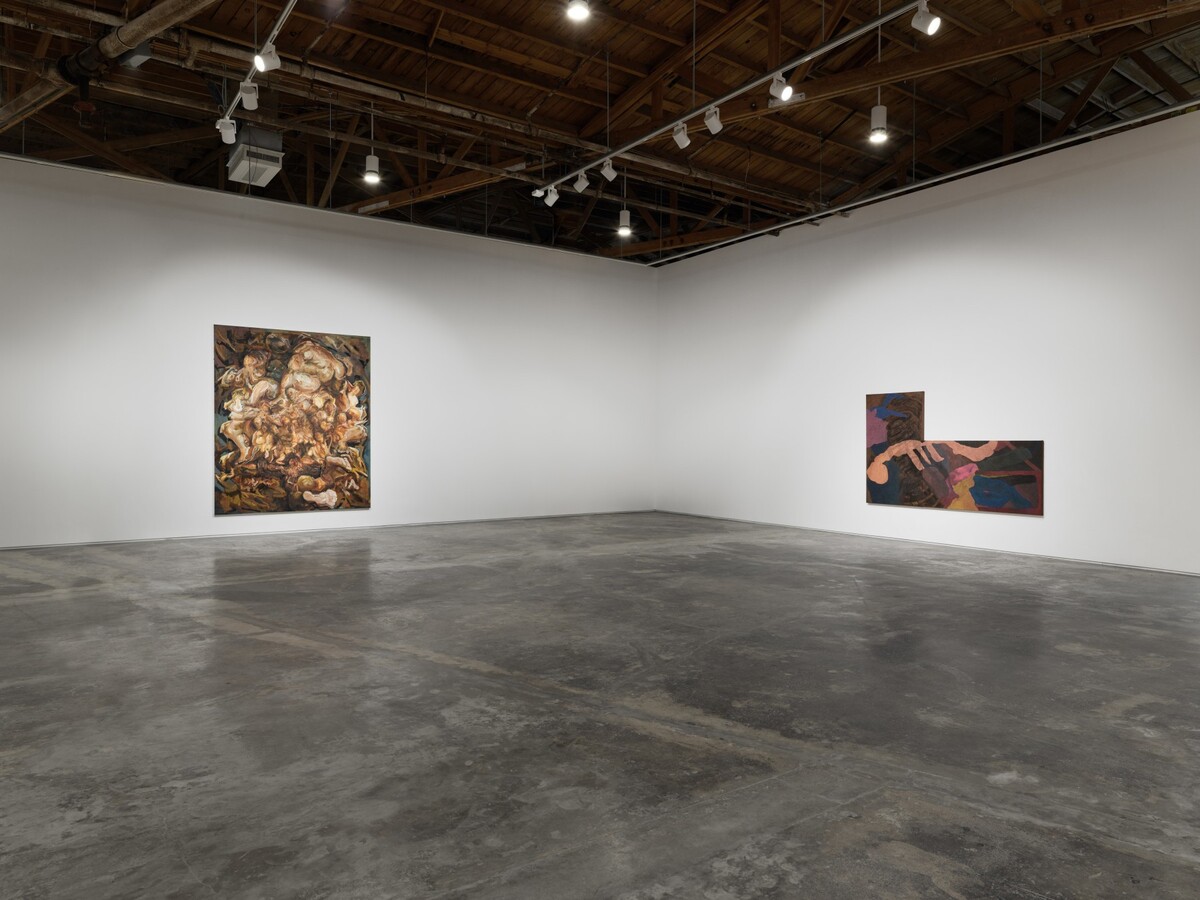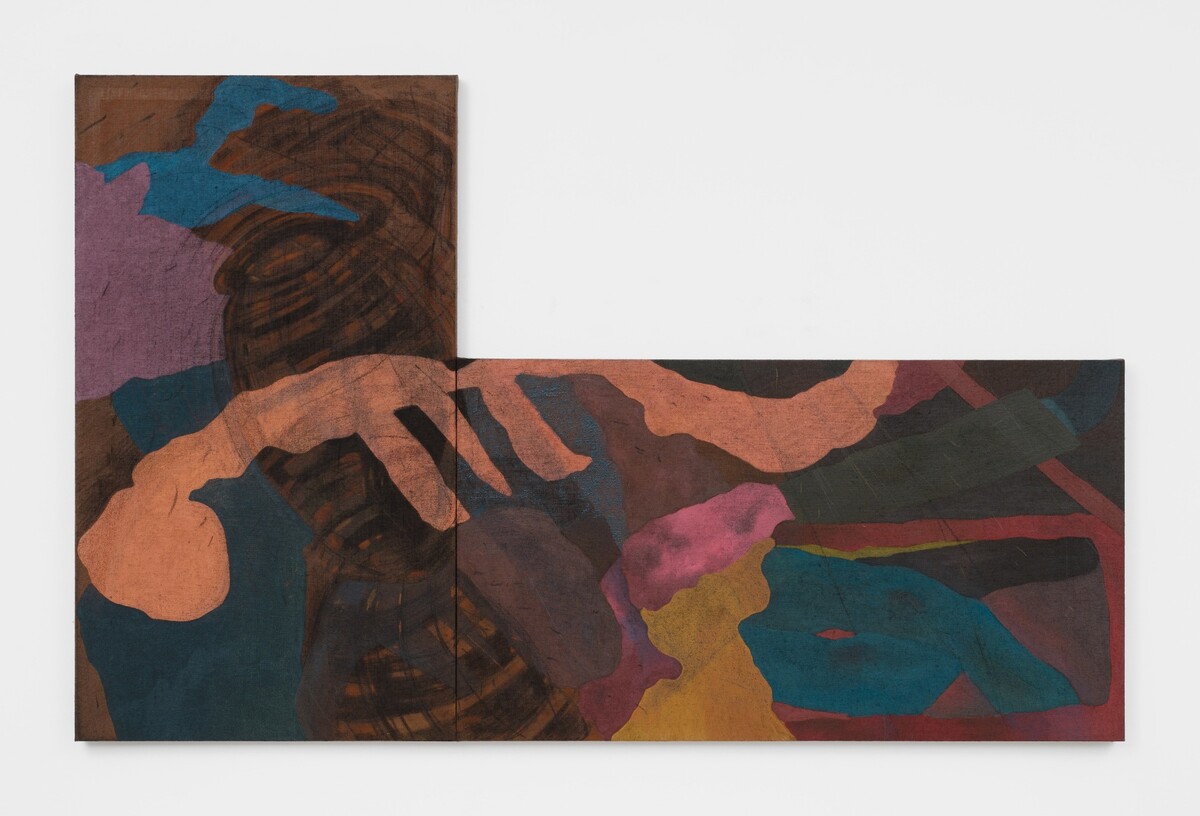
Both participating in and expanding the history of abstraction, multiple artists in The Big Picture demonstrate the evolving influence of Abstract Expressionism and Color Field painting while also developing their own inventive techniques for removing the artist’s hand. Andrea Marie Breiling renders kinetic works of abstraction using spray paint, an unexpected medium that has become her signature. Sweeping marks invoke the artist’s full body, as complex layers of color establish an ethereal tone. Sarah Blaustein repurposes tools of domestic labor for her artistic practice, using household items such as sponges, brooms, buckets, and housepainters’ brushes or rags to apply ink and acrylic paint to canvas. The process becomes what Blaustein has described as a “bodily dance” in which she attempts to capture momentary sensations and achieve a meditative state. Kaveri Raina paints on the front and back of stretched burlap, allowing pigments to bleed through the material’s textured surface. The resulting overlapping shapes appear as ominous shadows or maps of mysterious psychological terrain.
Artists such as Iva Gueorguieva, Nigel Cooke, and Janaina Tschäpe blend mediums and forms, often combining elements of abstraction and figuration. Integrating materials such as gauze on her paintings’ surfaces, Guergouieva looks to the materialism of Art Povera, the physicality of Gutai, and the playfulness of Cubist collage to create works layered with palimpsests and partially visible images. Cooke subverts classical painting techniques of spatial depth to create works that convey the complexities of brain circuitry, human anatomy, and the natural world, while Janaina Tschäpe’s dreamlike paintings similarly blur the lines between aquatic, plant, and human forms, referencing her interests in mythology and biological morphology.
Other painters use the medium to generate abstracted depictions of places and the complex histories they contain. In paintings composed of bold lines and blocks of bright color, Atlanta-based artist Hasani Sahlehe draws upon his experiences growing up in the Caribbean and the improvisational approaches of Black musical traditions, visually translating a charged tension between repetition and rhapsody. Radcliffe Bailey, who also lived and worked in Atlanta until his recent passing, mined his own family history to pursue broader inquiries into Black history and cultural expression. In Bailey’s monochromatic black painting Maroon—which incorporates materials such as Georgia clay and black sand—the shapes of ladders, oars, and other objects subtly protrude from the canvas while evading outright visual recognition, an apt metaphor for the obliqueness of the past. Painting with solid gestures and thick paint layers, Márcia Falcão articulates relationships between the female body and pictorial matter. Her central motif is the carioca suburbs where she grew up, lives, and works in Rio de Janeiro. She depicts fleshy bodies in tangles of brown and red, merging the unruliness of her figures with the structured grid of the canvas.
Veering from abstraction toward narrative, other artists reimagine stories from folklore and mythology—whether from received traditions or their own invented worlds. Robert Nava is known for paintings of fantastical creatures in acrylic, oil stick, and graphite pencil in blunt, kinetic lines, overlaid with spray paint. These creatures merge mythological characters that have persisted over millennia (gryphons, dragons, and witches, among others) with impulsive contemporary flourishes (airplanes, buses, electric currents, flamethrowers). Nava’s monsters offer new archetypes of the present day, intuitively combining ancient folklore with the mundane machinery of twenty-first-century life. In The Invocation of Queen Mab, Carrie Moyer celebrates a figure described as “the fairies’ midwife” in Shakespeare’s Romeo and Juliet who would, in later representations, be portrayed as “the queen of the fairies.” Showing fiery washes of color descending from two dome-like shapes above a glittery grayscale sea, Moyer’s painting brings a sense of the theatrical and a distinctively feminine perspective to a medium and scale that have often historically been associated with macho bravado.
Informed by comic books, cartoons, and film, Trenton Doyle Hancock has developed his own fantastical universe known as the “Moundverse” across works in painting, sculpture, and other mediums. In Bringback Condiments: Ketchup, Hancock depicts characters known as the “Bringbacks,” mouthless, fur-striped humanoids who serve a nostalgic function: they “bring back” memories from childhood. For Hancock, the Bringbacks allow him to revisit formative influences on his creation of the Moundverse.
Across this range of styles and subject matter, the paintings in The Big Picture assert each artist’s own distinctive visual language. What unites these works is not aesthetic, conceptual or technical, but a spirit of unbridled ambition. Through each of their idiosyncratic approaches, each artist asserts that there is still space to explore within the enterprise of painting.

